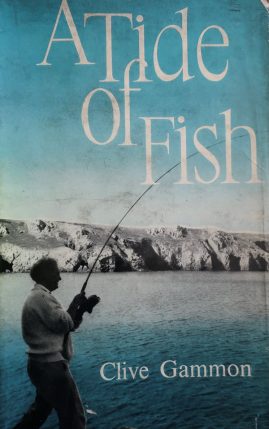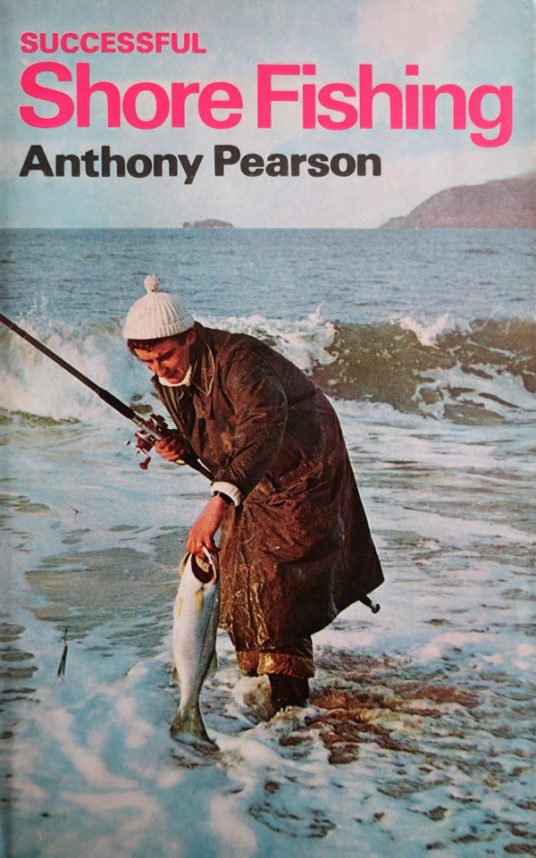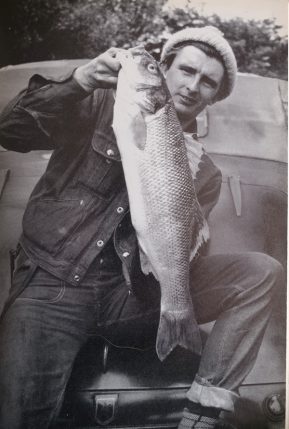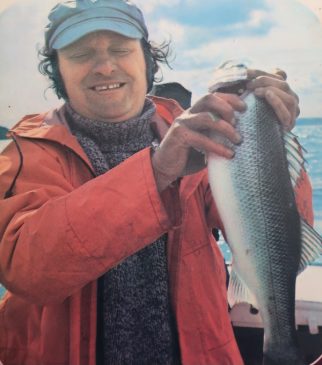Most of us buy books about sea fishing, and the majority of these will be manuals on how to catch fish. These are essential for anyone starting out in the sport, and also for experienced fishermen wanting to try a new method such as fly fishing. However, the books we grow to love are not the how-to manuals, but those that consist of fishing stories, and the reasons why we fish. Two books of this type stand out if you fish from the shore, and both deal in the main with bass. These are Clive Gammon’s A Tide of Fish and Anthony Pearson’s Successful Shore Fishing. Clive Gammon’s name will be familiar to most readers, particularly as he was one of the founding members of B.A.S.S. and its first Chairman; Anthony Pearson’s less so. Both books were written well before the popularity of lure fishing for bass, so concentrate mainly on bait fishing.
 Clive Gammon’s A Tide of Fish was published in 1962. It includes 13 pages of black and white photos, and the cover is a black and white photo, tinted with blue, of the author playing a tope at Barafundle. The 167 pages of text describe Gammon’s experiences of shore fishing along the South Wales coast; mostly for bass. He starts in the west, with the superb surf fishing at Freshwater West, and finishes at Swansea, taking in Milford Haven en route. The chapter on fishing the famous surf beach, Freshwater West, is excellent, and describes a quality of fishing we can now only dream about. Gammon describes one particular night when the entire beach was filled with fish, with bites coming every 15 minutes from a range of 15 yards from the shore out to maximum casting distance. Although the book is mainly about bass fishing, for me the stand out chapter is that dealing with catching large tope from the rocks at Barafundle. This, I think, is probably the most exciting writing ever produced about shore fishing in the UK. Gammon was not a pioneer of this fishing; he tagged along later, and one strange aspect of the account is that the tope were discovered after an angler caught two skate each around 50 lb. in weight, but skate catches by Gammon and his companions don’t feature in the book, or elsewhere in Gammon’s writings. The thing that strikes you most about this book, and much of Gammon’s other work, is the quality of the writing. Gammon never went into much detail about the technicalities of fishing, and so this book could be read by anyone interested in the South Wales coastline.
Clive Gammon’s A Tide of Fish was published in 1962. It includes 13 pages of black and white photos, and the cover is a black and white photo, tinted with blue, of the author playing a tope at Barafundle. The 167 pages of text describe Gammon’s experiences of shore fishing along the South Wales coast; mostly for bass. He starts in the west, with the superb surf fishing at Freshwater West, and finishes at Swansea, taking in Milford Haven en route. The chapter on fishing the famous surf beach, Freshwater West, is excellent, and describes a quality of fishing we can now only dream about. Gammon describes one particular night when the entire beach was filled with fish, with bites coming every 15 minutes from a range of 15 yards from the shore out to maximum casting distance. Although the book is mainly about bass fishing, for me the stand out chapter is that dealing with catching large tope from the rocks at Barafundle. This, I think, is probably the most exciting writing ever produced about shore fishing in the UK. Gammon was not a pioneer of this fishing; he tagged along later, and one strange aspect of the account is that the tope were discovered after an angler caught two skate each around 50 lb. in weight, but skate catches by Gammon and his companions don’t feature in the book, or elsewhere in Gammon’s writings. The thing that strikes you most about this book, and much of Gammon’s other work, is the quality of the writing. Gammon never went into much detail about the technicalities of fishing, and so this book could be read by anyone interested in the South Wales coastline.
Pearson is a bit of an enigma, whereas Gammon’s history is reasonably well known. However, I haven’t studied Gammon to the same degree with which I have studied Pearson, so the following biography of Gammon draws, in part, upon the account in Phill Williams’ excellent book You Should Have Been Here Yesterday (2019) and an obituary in The Telegraph. Gammon was born in Swansea on 29 March 1929; the son of an electrician. His grandfather taught him to fish, catching whiting from Swansea West Pier. Later, during the Second World War, he used to travel by bus to fish Rhossili beach for bass. Sometimes there was no return bus, and he and his friends had to walk the 18 miles home. He attended Manchester University, where he obtained a BA in English, and then went on to obtain a Master’s degree in English at Oxford. According to Phill Williams the thesis was entitled ‘The Literature of Angling 1496 to 1750’, but an obituary in The Telegraph newspaper claims it was about Izaak Walton, author of The Compleat Angler.
His first job was as a teacher at Stand Grammar in Manchester in 1953, but he soon got a job teaching at Pembroke Grammar School. It was during this period that he fished for bass at Freshwater West and other Castlemartin Peninsula beaches, tope from the rocks at Barafundle, and wrote A Tide of Fish at the age of 33. This was not his first book, as Hook, Line & Sinker had been published in 1959 and The Fisherman’s Fireside Book in 1961. He was also writing for various angling publications such as Angling Times and Creel, and The Sunday Times under the pseudonym Nicholas Evans.
At some point during the 1960s he gave up his teaching job and moved to London to pursue a full-time career as an angling journalist, and also as television critic for The Spectator. It may seem a bit strange that he gave up the idyllic lifestyle depicted in A Tide of Fish, but there are hints in the book that he was not entirely happy. He was opposed to the construction of oil terminals in Milford Haven, and the departure from the area of his fishing companion John Barratt was a bitter blow. Among the publications Gammon was now writing for was the American magazine Sports Illustrated. They eventually offered him a full-time job, and at some point in the 1970s, possibly 1976, he moved to New York. This was a sad blow for UK angling journalism, but a fantastic opportunity for Gammon. He travelled all over the world to cover sports stories. On one occasion he was in Yucatan, Mexico when the racehorse Shergar was kidnapped. Sports Illustrated sent a private jet to pick him up, flew him by Concorde to London, and then on to Ireland. He also covered ‘the rumble in the jungle’ involving a boxing match between Muhammad Ali and George Foreman at Kinshasa in 1974. He was a close personal friend of Muhammad Ali. Sports Illustrated also financed fishing trips for Gammon, and some of these are described in his two final books I Know a Good Place (1989) and Castaway (2005). Gammon became an American citizen, but when he retired he moved back to South Wales. He did a bit of bass fishing and attended some B.A.S.S. AGMs. He entered sheltered accommodation in 2010, and died on 10 June 2012 at the age of 83. An interview can be heard with Gammon the year before he died on Phill Williams’ website https://www.fishingfilmsandfacts.co.uk/.
 Anthony Pearson’s Successful Shore Fishing was published in 1967. It includes 32 pages of black and white photos, so more than twice as many as Gammon’s. The cover is in colour, and depicts Pearson landing a large bass at a surf beach. It is possibly the best cover on any fishing book. The text, at 188 pages, is slightly longer than Gammon’s book, but includes some preliminary chapters on subjects such as tides, beach types, tackle selection, and camping gear. The main part of the book covers Pearson’s experiences whilst fishing the east coast, and north-west coast, for cod, and Wales and southern Ireland for bass. There are interludes for other species as well, such as the 102 lb. skate caught from Fenit Pier on a beachcasting rod and fixed-spool reel. It is difficult to select a stand-out chapter, as all are excellent, but that relating to the Dingle Peninsula is particularly interesting, as it, like Gammon’s chapter on Freshwater West, describes a quality of fishing that is long gone. At one point, Pearson is fishing with Eammon Doyle at Castlegregory. Pearson’s first bass weighed 11½ lb., followed by two weighing 9 lb. and one weighing 8 lb. Between them they caught 31 fish, with one of Eammon’s just below 13 lb. The smallest weighed 5 lb.
Anthony Pearson’s Successful Shore Fishing was published in 1967. It includes 32 pages of black and white photos, so more than twice as many as Gammon’s. The cover is in colour, and depicts Pearson landing a large bass at a surf beach. It is possibly the best cover on any fishing book. The text, at 188 pages, is slightly longer than Gammon’s book, but includes some preliminary chapters on subjects such as tides, beach types, tackle selection, and camping gear. The main part of the book covers Pearson’s experiences whilst fishing the east coast, and north-west coast, for cod, and Wales and southern Ireland for bass. There are interludes for other species as well, such as the 102 lb. skate caught from Fenit Pier on a beachcasting rod and fixed-spool reel. It is difficult to select a stand-out chapter, as all are excellent, but that relating to the Dingle Peninsula is particularly interesting, as it, like Gammon’s chapter on Freshwater West, describes a quality of fishing that is long gone. At one point, Pearson is fishing with Eammon Doyle at Castlegregory. Pearson’s first bass weighed 11½ lb., followed by two weighing 9 lb. and one weighing 8 lb. Between them they caught 31 fish, with one of Eammon’s just below 13 lb. The smallest weighed 5 lb.
There is a very limited amount of information available about Pearson, and it is often speculative or incorrect. The following is based mainly upon information revealed by Pearson in his books and articles. Pearson was born on 28 April 1941 in Marple, a leafy suburb of Manchester. He was the son of a stores clerk, who was a keen fisherman. The family moved to Hawk Green, and Pearson was taught to fish by his father on the nearby Macclesfield Canal. The family moved again to Bolton, and this provided the young Pearson with opportunities to fish for trout in the local streams. Every year his father would take him fishing to southern Ireland, and it was here that Pearson caught his first bass. He was also travelling alone by train from Bolton to Blackpool to fish for cod.

Pearson did not do well at school, and left in 1957 with few, if any qualifications. He went to live with his much older brother, who was a senior police officer in Nairobi, Kenya. Here Pearson became a reporter for the East African Standard, and fished the local rivers and lakes for the introduced trout and largemouth bass. He also got involved in big-game fishing at Malindi. He returned to the UK around 1961/62 and got a job as a reporter with the Hull Daily Mail. This gave him an opportunity to fish the east coast for cod in winter and bass in summer. Around 1963/64 he moved to Manchester for a job with the Guardian. He became the paper’s fishing correspondent and appeared to have an arrangement whereby he could travel all over the UK, Europe and Africa to fish at the newspaper’s expense. He spent a lot of time fishing North Wales; the nearest piece of quality coastline to Manchester, and also southern Ireland; the beaches of Brandon Bay in particular. He recorded his fishing exploits in a fortnightly column in the Guardian, and also wrote articles for a number of magazines including Fishing, Creel, Angling, and Trout and Salmon. It was during this period that Pearson wrote Successful Shore Fishing, a remarkable feat for someone only 26 years old.
Pearson’s life started to unravel in the late 1960s. He was constantly broke. Fishing magazine, in which he wrote a monthly column, folded in December 1969, and it would appear that his arrangement with the Guardian was terminated, although he continued to write occasional articles for them for a few years more. He also appears to have lost his enthusiasm for shore fishing. Eventually, in the late 1960s/early 1970s he moved to London where the opportunities for freelance writing were presumably better. He stopped writing about fishing, and became a specialist in reporting about terrorism and the Middle East. He wrote a book, Conspiracy of Silence in 1978 about an incident that occurred during the Six Day War between Israel and a number of Arab nations. I wish I could report that his interest in surf fishing returned, and he had a happy retirement on the Dingle Peninsula. The sad truth is that he died unexpectedly in London on 28 July 1984 at the age of only 43.
Gammon and Pearson had a number of things in common. Both were fanatical about bass fishing, both wrote about fishing for magazines and newspapers, and both wrote books about fishing (Gammon about 20, and Pearson 4). They each produced a guide to fishing in Wales; Pearson in 1968 with Sea Fishing North Wales and Anglesey, and Gammon in 1974 with Angling Guide to Wales. They were also both responsible for opening up the bass fishing in Ireland; often fishing with Des Brennan and Kevin Linnane of what was then the Inland Fisheries Trust. Finally, they were both lost to UK angling readers, albeit for very different reasons. Did they ever meet? In a 1965 article in the Guardian newspaper Pearson describes fishing with someone called Clive at Castlegregory on the Dingle Peninsula, and this is confirmed by Gammon in the January 1968 issue of Angling magazine. It should also be mentioned that in a 1966 Guardian article Pearson describes tope fishing from the rocks in Pembrokeshire with someone called John, who can only have been Gammon’s companion John Barratt.

So, who was the best bass fisherman, and which is the best book? I don’t think that there can be any doubt that Pearson was the better bass fisherman, particularly if we judge it by the size of fish caught. Most of Gammon’s bass fishing was in Pembrokeshire, and although he was fishing in the 1950s when the bass population was at its peak, average bass sizes were known to be small in this area, and according to Phill Williams, he only caught one double figure fish – from the Gower Peninsula. Pearson fished mainly in North Wales, where the average bass size was higher. In Sea Fishing North Wales and Anglesey he records catching 18 double figure fish in one year, including a 14 pounder, and this was despite him fishing in the 1960s, when the bass population was declining due to recreational fishing. Pearson took a fanatical approach to fishing, often fishing five or six tides a week, some sessions lasting 10 hours, and sometimes in weather conditions that would send most people home. It should be mentioned, however, that Gammon fished with more finesse; using light rods and leads, whereas Pearson fished with powerful beachcasters and heavy leads, necessitated, in part, by the powerful lateral currents he experienced on beaches such as Dinas Dinlle. Regarding which is the best book, I have to concede that although my favourite is Successful Shore Fishing because I know the North Wales sites it describes so well, A Tide of Fish is superior. It benefits from describing a smaller stretch of coast in detail, and Gammon was a superlative writer, which is to be expected given that he had two English degrees and a Welshman’s love of language.
As far as availability and price are concerned, Successful Shore Fishing is the commoner of the two, with prices starting at around £30 to £40. A Tide of Fish is scarcer, with prices starting at around £140 in shops, but occasionally much cheaper on ebay. Other recommended books of a similar nature are The Call of the Surf (1924) by Van Campen Heilner, Salt Water Fishing in Ireland (1966) by Clive Gammon, Successful Shore Angling (2011) by Phil Arnott, and Angling on the Edge (2019) by Mike Ladle and Steve Pitts, and if you prefer light tackle or lure fishing, anything by Mike Ladle.
Shorefishing With Anthony Pearson (ISBN: 978-1-904784-45-6), introduced and edited by Richard Baker, consists of a biography of Pearson and all 103 of his shore fishing articles published in Fishing magazine, Angling magazine, and the Guardian newspaper during the 1960s and 1970s. It will be available from Coch-y-Bonddu Books from 27 March 2023 as a flapped paperback of 477 pages, with a limited edition of 250 numbered signed copies. Price £30.
Author: Richard Baker